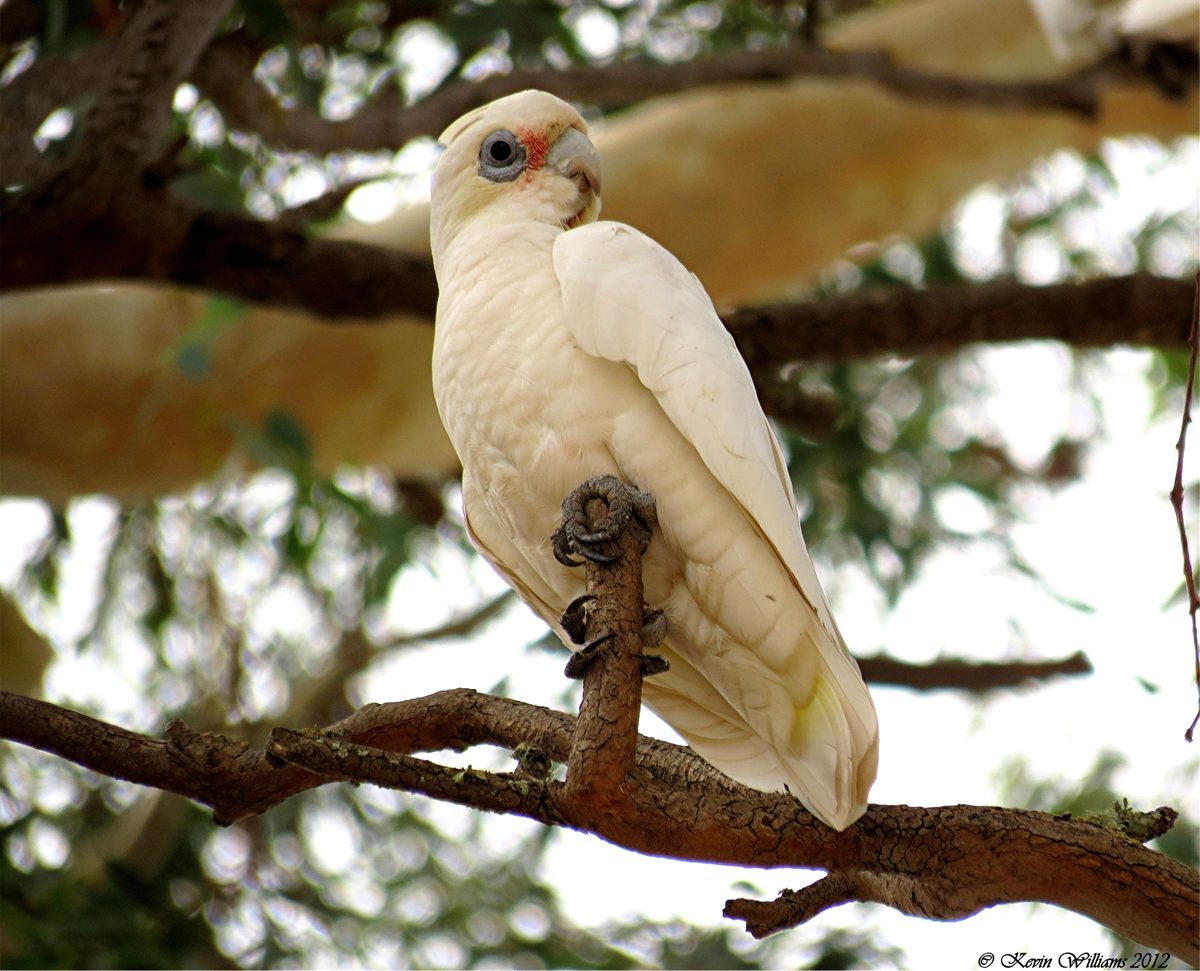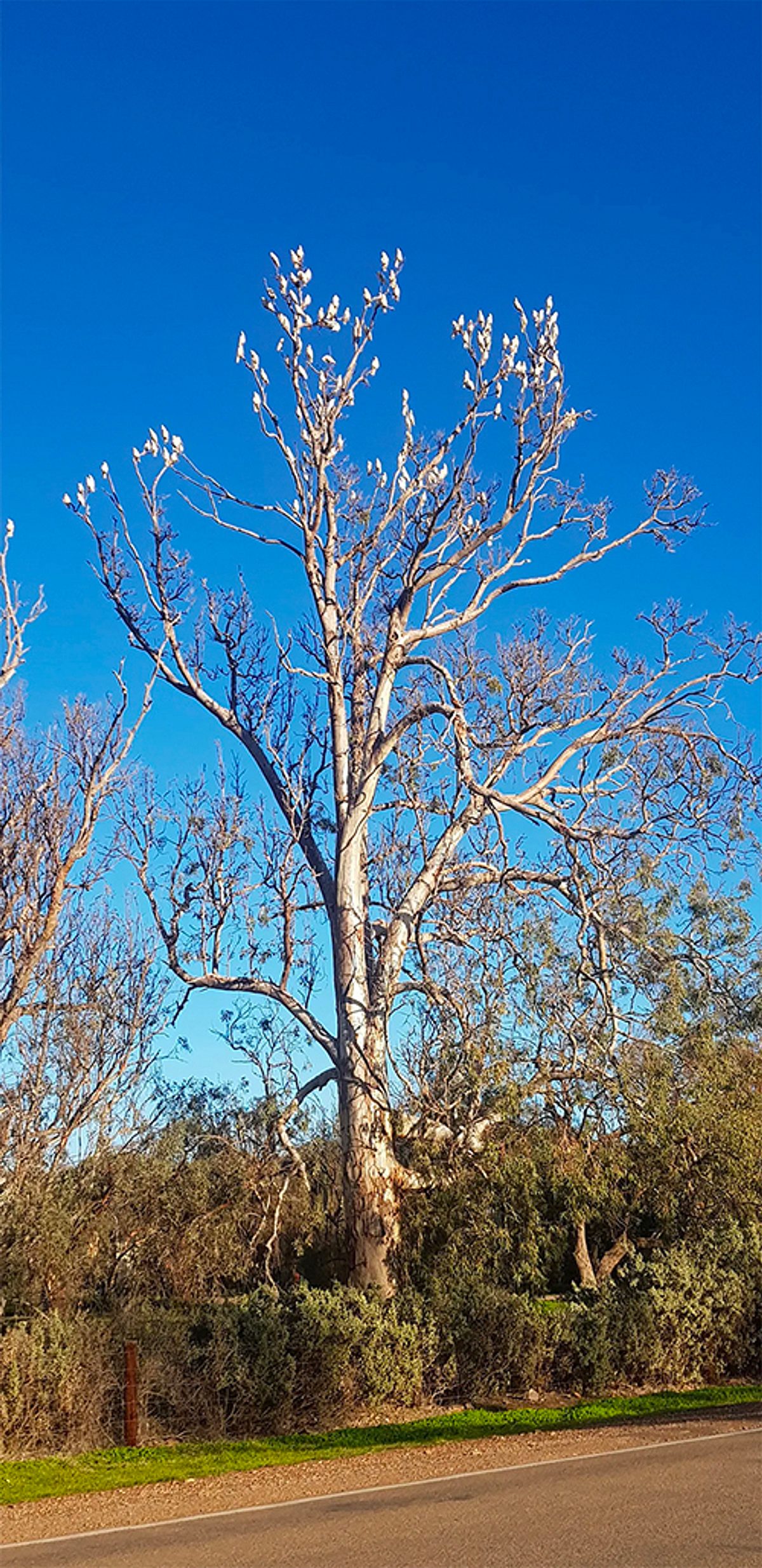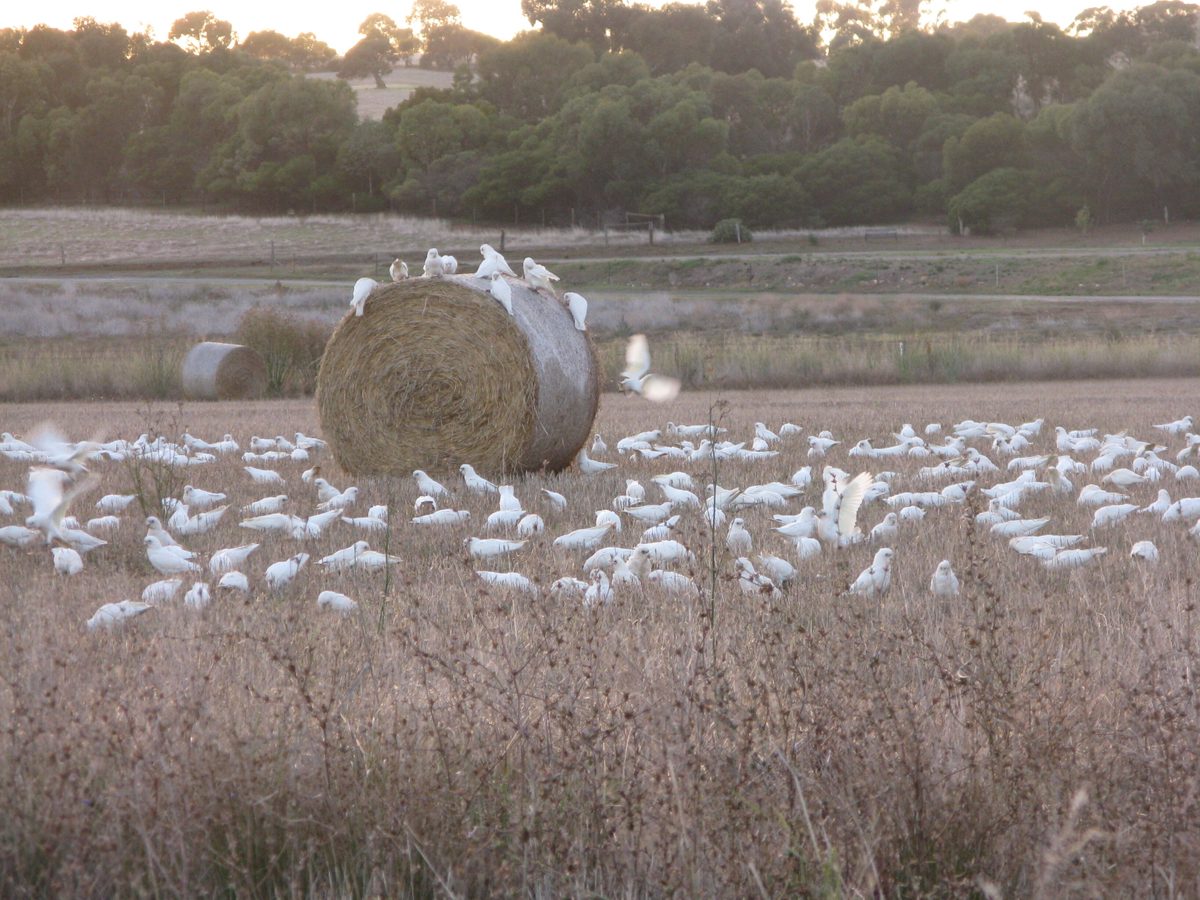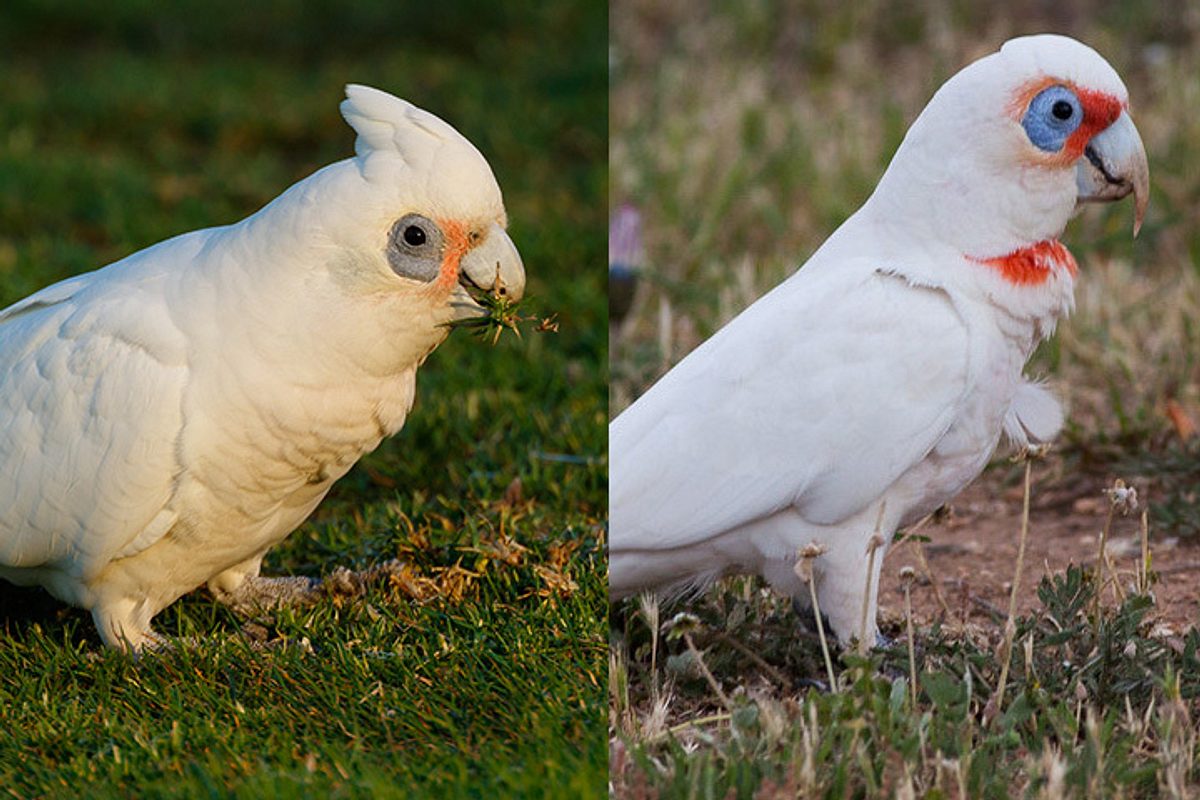Little Corellas
What is a Little Corella?
Little Corellas (Cacatua sanguinea) are small white parrots, up to around 40 cm in length, with a noticeable blue eye ring and pale pink feathers between the eyes and beak.
Prior to the 1960s, Little Corellas were mainly located in remote areas in the far north of the South Australia, but now they are regular visitors to Adelaide urban and peri-urban areas, and country towns stretching from the Flinders Ranges to the South East of the state. They are ‘urban adaptors’ meaning they have benefitted greatly from the environments we have created with wide open spaces and ready supplies of food and water, and have accordingly changed their behaviours and are likely increasing in numbers. Large noisy flocks usually arrive in urban areas in approximately December and stay until about March. In Autumn, flocks disperse and they return to the rural areas to breed. They pair for life and prefer to return to the same nesting hollow.
Little Corellas feed mainly on grains and grass seeds, but also bulbs and fruits. They rely on water from lakes, troughs, dams, tanks, and creeks which are freely available in our urban and peri-urban environments. They are intelligent birds, and are often observed ‘playing’ such as hanging by one foot, repeatedly sliding down roofs, and have been seen swinging around on rotating windmill blades.
Little Corellas are an unprotected species in South Australia. No permit is required from the Department for Environment and Water to destroy Little Corellas by shooting, but a permit is required from the department, in accordance with the National Parks and Wildlife Act 1972 (NPW Act), where destruction is planned any other means. Any destruction must be done in a manner that is compliant with other requirements of the NPW Act, the Animal Welfare Act 1985 and other relevant legislation, particularly those governing the use of firearms.

What are the issues caused by Little Corellas?
Because of their innate behaviours and the ideal environments that we’ve created for the species, Little Corellas can cause a variety of impacts on people, infrastructure, industry and the environment.
With food and water readily accessible in or near urban or town environments, Little Corellas can have ample of time for play. Some of this play involves chewing infrastructure, which can cause costly damage. Infrastructure like wiring, antennas, solar panels, street and sports ground lighting, artificial grass, shade sails and cabling can be particularly susceptible.
Little Corellas can damage built and natural assets when feeding or maintaining roosts. Grassed parklands and playing fields are damaged by feeding Little Corellas when they dig for bulbs. Introduced and native trees are sometimes pruned by Little Corellas when roosting or when they establish perches which allow them to be on the lookout for predators. Trees in parks and gardens where Little Corellas are generally free from threats posed by natural predators or human harassment can be focal points for sometimes large and noisy flocks. The impacts of these large flocks can reduce the visual amenity of the trees in which they roost and perch.
Little Corellas can impact primary production by taking grain from newly seeded paddocks and grain storages, they can damage fruit in orchards, and their chewing can sometimes damage irrigation systems.
People’s wellbeing can be affected by Little Corella flocks which create a significant noise nuisance from their loud screeching, and by fouling pathways, public grounds, and private properties. The sometimes chronic and intractable nature of Little Corella impacts can sometime affect people’s mental wellbeing. If you feel your mental health is being affected by Little Corellas please speak to your general practitioner or consult the services available on the SA Health Mental Health Services website.

What can be done to manage their impact?
A range of activities are undertaken by landowners and managers to minimise the impacts of Little Corellas. These include:
- surveys, bird counts and mapping to better understand the species and their behaviour
- scaring birds using loud noises and flashing lights or lasers to move them from problem areas
- protection of assets such as cabling or lighting by shielding or caging
- modifying parks and gardens to make them less attractive to Little Corellas
- trialling some other scaring techniques such as drones, falconry, scaring balloons, and water cannons and installing screening
- humane destruction at problem sites.
The Department for Environment and Water encourages an integrated and coordinated management approach across state and local governments, regional organisations, businesses, communities and private landholders, using a variety of Little Corella management methods.
The National Parks and Wildlife Service and Landscape Boards are available to provide advice on the management of Little Corellas, and the department should be contacted if a destruction is sought by a means other than a firearm. Also, the state government and some Landscape Boards are funding research to better understand the movement patterns and flock dynamics of the species and efficacy of management tools to ensure that management efforts have the maximum impact.

Management options
DEW regulates the conservation and management of wildlife by the community in accordance with the NPW Act. Managing Little Corellas is the responsibility of landholders and land managers, where they choose to do so, in order to reduce the impacts caused by the species to acceptable levels to protect their livelihoods, safety and environmental assets, where that management is consistent with the NPW Act and other legislative requirements. If you are being impacted by Little Corellas you may wish to attempt some of these methods to alleviate impacts.
Scaring techniques
Scaring techniques which use light or sound are designed to make the Little Corellas fear danger and move away from locations where they are causing issues.
Making loud noises may make Little Corellas feel that the site is uncomfortable or dangerous. Techniques include clap boards, starter pistols, sirens, loud speakers and firearms (where it is safe and legal to do so). Visual deterrents are usually a form of bright flashing lights or lasers shone into their roosting sites, particularly at dawn or dusk. It is recommended that torches or strobe lighting are used in conjunction with loud noises. Other visual scaring products are available that simulate predators, such as scare eye balloons, which have designs of the large eyes of a predator, and can be raised into trees to scare birds. Kites are also sometimes used which look like birds of prey.
Little Corellas are highly intelligent birds and can quickly learn these sights and sounds are not associated with an actual threat, so the efficiency of these tools may reduce over time. Shooting in conjunction with non-lethal scaring methods may reinforce the utility of the non-lethal methods.
Habitat modification
Habitat modification options are based on attempting to limit the Little Corella’s access to food and water, or by making them feel unsafe from predation. Little Corellas feed mostly on the ground and prefer a clear line of sight to feel safe from predators. Management options include placing screens or planting screening plants that block the Little Corella’s line of sight at feeding or drinking locations. Similarly, plantings around the bases of roost may make Little Corellas uncomfortable due to fear of approaching predators.
Other habitat modification measures relate to attempting to reduce access to food and water. Where possible, the banks of water sources such as dams and lakes could be planted with reeds and rushes which will exclude Little Corellas access. Limiting access to food resources is quite difficult, but some actions may be taken such as covering grain piles and removing any other unnecessary food or water supplies.
Asset protection
Little Corellas can damage built infrastructure by chewing. Where possible, protect easily chewed assets with metal shielding or piping, or look to exclude Little Corellas from the asset with caging, mesh or netting. Remember to use wildlife-safe netting wherever possible.
Destruction
The department frequently hears calls for culling of Little Corellas. While localised destruction can be effective, particularly when used as part of an integrated approach incorporating a variety of short-, medium- and long-term non-lethal management actions, broad-scale destruction of Little Corellas to reduce their numbers is not practical.
As an unprotected species in South Australia, it is legal to shoot Little Corellas without a destruction permit. All shooting must be done in compliance with other requirements of the NPW Act, the Animal Welfare Act 1985 and other relevant legislation, particularly those governing the use of firearms. The Code of practice for the humane destruction of birds by shooting in South Australia (updated) provides guidance on suitable firearm and ammunitions combinations for shooting Little Corellas. Care is required to distinguish the unprotected Little Corella from the Long-billed Corella which is a fully protected species in South Australia.

In accordance with the NPW Act, permits are required to destroy Little Corellas by a means other than a firearm. Subject to training and accreditation, the department may issue a Permit to Destroy Flocking Birds by Trapping and Carbon Dioxide Narcosis. See our webpage for information on destruction of wildlife (unprotected) for application details. While this is a humane method of destruction when done accordance with the relevant Code of Practice, it is a complex and resource intensive method. People considering destruction of the Little Corellas by this method should contact the department to discuss its suitability to their situation. It is not legal to poison Little Corellas.
More information
Information on legal obligations related to Little Corella management
- See the codes of practice for the humane destruction of wildlife
- Find out if you need a permit to destroy little corellas on your property
- Find out if you need a permit to hunt (take) little corellas from the wild
A number of research documents are provided below that provide more detail. Please note that the information in them is relevant at the time of publication. Conclusions and recommendations provided in the reports below may not reflect the current science and community values. For further information, please email Wildlife@sa.gov.au.
Title: Little Corellas – A Way Forward
Author: Annette Scanlon and Philp Roetman, Discovery Circle Initiative, University of South Australia, Adelaide
Date published: 2018
Title: Little Corellas: Social and Ecological Research for Management in South Australia
Author: Annette Scanlon, Philp Roetman, Michael Stead, Steven Gray and Mark Lethbridge, Discovery Circle Initiative, University of South Australia, Adelaide
Date published: 2017
Title: Managing Impacts of the Little Corella on the Fleurieu Peninsula
Author: Ian Temby, M App Sc, Churchill Fellow 1999
Date published: 2010
Title: Little Corella (Cacatua sanguinea) Resource document
Author: Department of Environment and Heritage
Date published: 2007
Title: Corella Research Project; Towards integrated management of the Little Corella on the Fleurieu Peninsula
Author: QED Pty Ltd City of Onkaparinga
Date published: 2003


